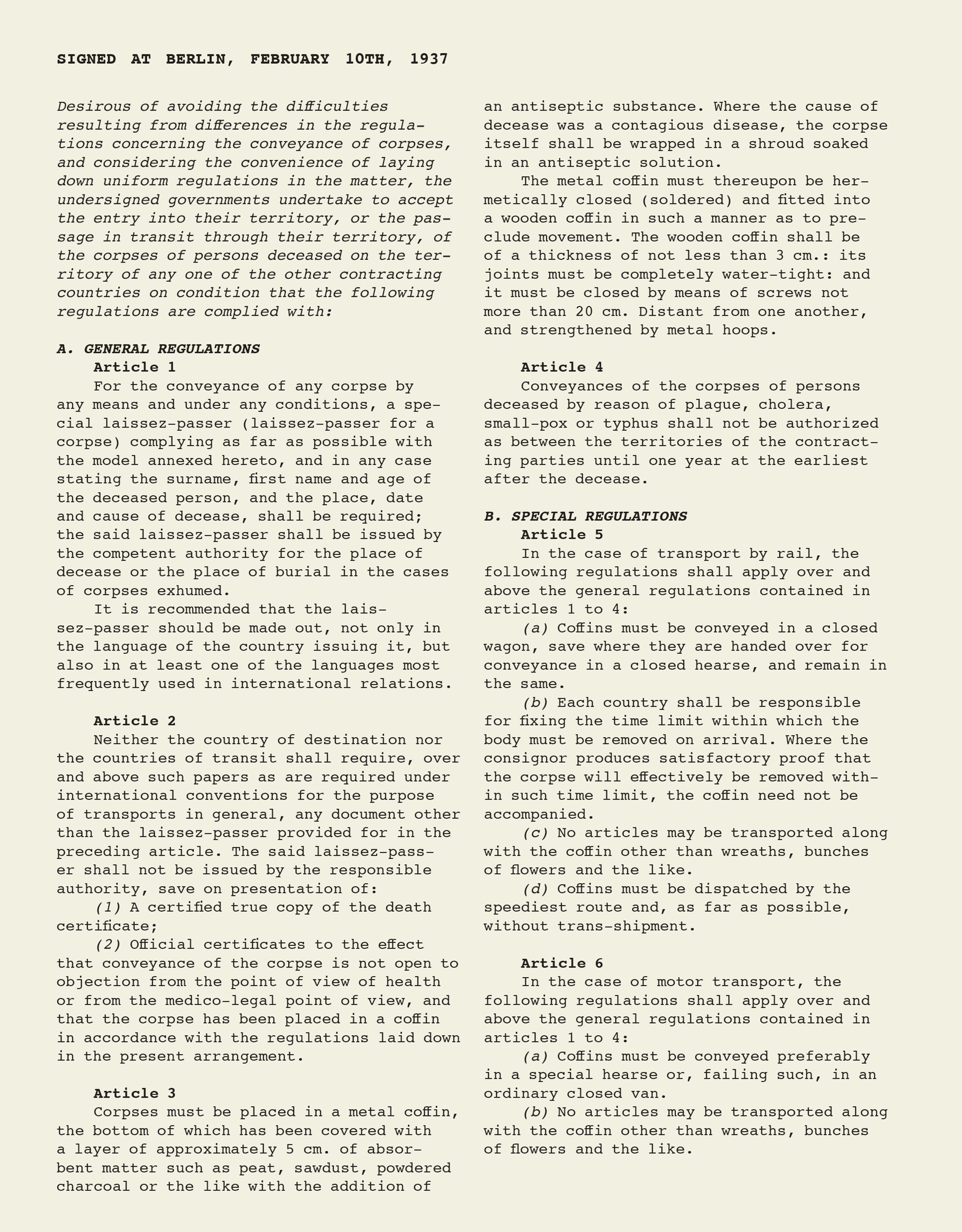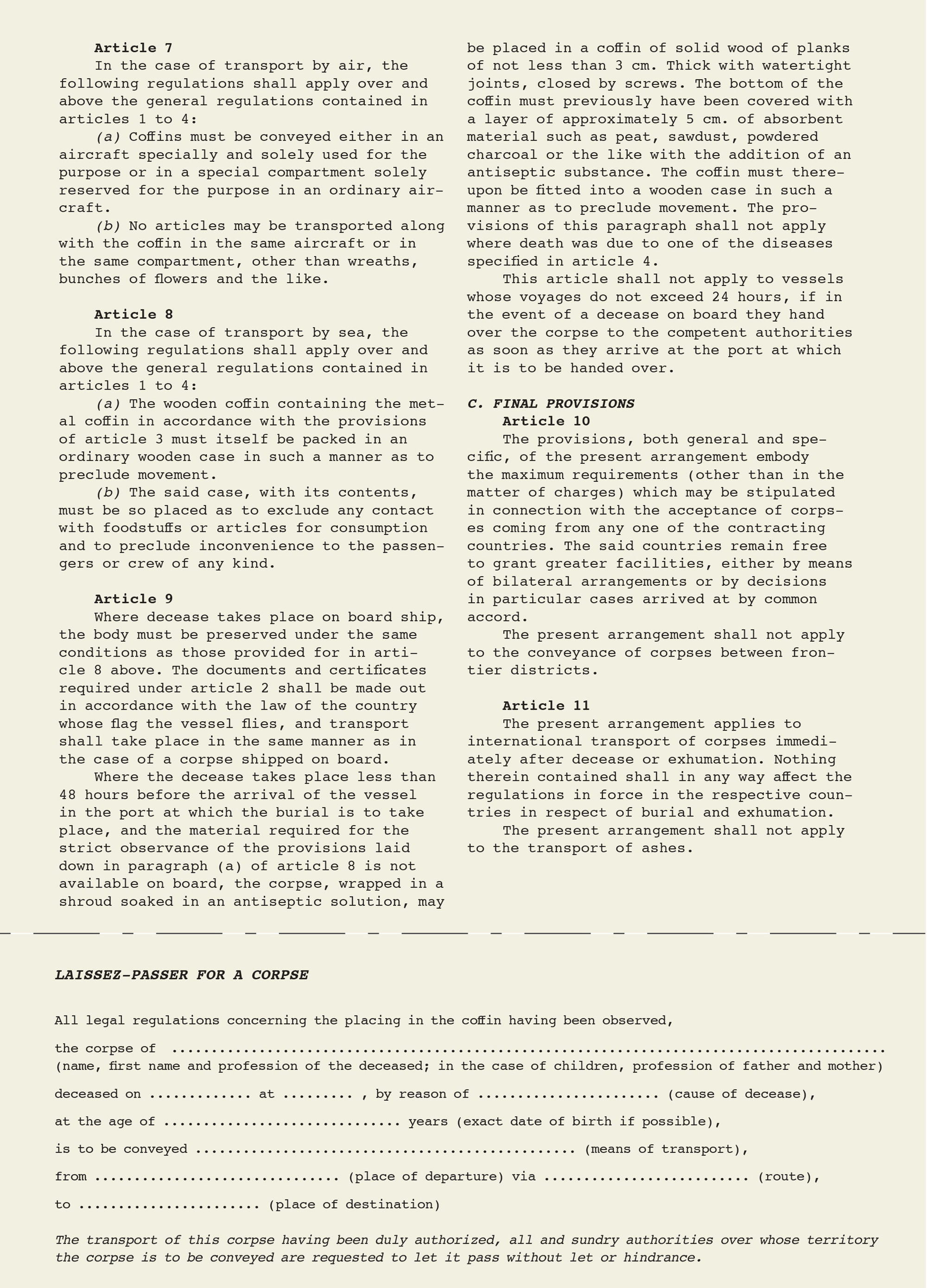Leftovers / International Arrangement Concerning the Conveyance of Corpses
If a body catch a body
League of Nations
“Leftovers” is a column that investigates the cultural significance of detritus.
Article 1
For the conveyance of any corpse by
any means and under any conditions, a special
laissez-passer (laissez-passer for a
corpse) complying as far as possible with
the model annexed hereto, and in any case
stating the surname, first name and age of
the deceased person, and the place, date
and cause of decease, shall be required;
the said laissez-passer shall be issued by
the competent authority for the place of
decease or the place of burial in the cases
of corpses exhumed.
It is recommended that the laissezpasser should be made out, not only in the language of the country issuing it, but also in at least one of the languages most frequently used in international relations.
Article 2
Neither the country of destination nor
the countries of transit shall require, over
and above such papers as are required under
international conventions for the purpose
of transports in general, any document other
than the laissez-passer provided for in the
preceding article. The said laissez-passer
shall not be issued by the responsible
authority, save on presentation of:
(1) A certified true copy of the death certificate;
(2) Official certificates to the effect that conveyance of the corpse is not open to objection from the point of view of health or from the medico-legal point of view, and that the corpse has been placed in a coffin in accordance with the regulations laid down in the present arrangement.
Article 3
Corpses must be placed in a metal coffin,
the bottom of which has been covered with
a layer of approximately 5 cm. of absorbent
matter such as peat, sawdust, powdered
charcoal or the like with the addition of
an antiseptic substance. Where the cause of
decease was a contagious disease, the corpse
itself shall be wrapped in a shroud soaked
in an antiseptic solution.
The metal coffin must thereupon be hermetically closed (soldered) and fitted into a wooden coffin in such a manner as to preclude movement. The wooden coffin shall be of a thickness of not less than 3 cm.: its joints must be completely water-tight: and it must be closed by means of screws not more than 20 cm. Distant from one another, and strengthened by metal hoops.
Article 4
Conveyances of the corpses of persons
deceased by reason of plague, cholera,
small-pox or typhus shall not be authorized
as between the territories of the contracting
parties until one year at the earliest
after the decease.
In the case of transport by rail, the following regulations shall apply over and above the general regulations contained in articles 1 to 4:
(a) Coffins must be conveyed in a closed wagon, save where they are handed over for conveyance in a closed hearse, and remain in the same.
(b) Each country shall be responsible for fixing the time limit within which the body must be removed on arrival. Where the consignor produces satisfactory proof that the corpse will effectively be removed within such time limit, the coffin need not be accompanied.
(c) No articles may be transported along with the coffin other than wreaths, bunches of flowers and the like.
(d) Coffins must be dispatched by the speediest route and, as far as possible, without trans-shipment.
Article 6
In the case of motor transport, the
following regulations shall apply over and
above the general regulations contained in
articles 1 to 4:
(a) Coffins must be conveyed preferably in a special hearse or, failing such, in an ordinary closed van.
(b) No articles may be transported along with the coffin other than wreaths, bunches of flowers and the like.
Article 7
In the case of transport by air, the
following regulations shall apply over and
above the general regulations contained in
articles 1 to 4:
(a) Coffins must be conveyed either in an
aircraft specially and solely used for the
purpose or in a special compartment solely
reserved for the purpose in an ordinary aircraft.
(b) No articles may be transported along with the coffin in the same aircraft or in the same compartment, other than wreaths, bunches of flowers and the like.
Article 8
In the case of transport by sea, the
following regulations shall apply over and
above the general regulations contained in
articles 1 to 4:
(a) The wooden coffin containing the metal coffin in accordance with the provisions of article 3 must itself be packed in an ordinary wooden case in such a manner as to preclude movement.
(b) The said case, with its contents, must be so placed as to exclude any contact with foodstuffs or articles for consumption and to preclude inconvenience to the passengers or crew of any kind.
Article 9
Where decease takes place on board ship,
the body must be preserved under the same
conditions as those provided for in article
8 above. The documents and certificates
required under article 2 shall be made out
in accordance with the law of the country
whose flag the vessel flies, and transport
shall take place in the same manner as in
the case of a corpse shipped on board.
Where the decease takes place less than 48 hours before the arrival of the vessel in the port at which the burial is to take place, and the material required for the strict observance of the provisions laid down in paragraph (a) of article 8 is not available on board, the corpse, wrapped in a shroud soaked in an antiseptic solution, may be placed in a coffin of solid wood of planks of not less than 3 cm. Thick with watertight joints, closed by screws. The bottom of the coffin must previously have been covered with a layer of approximately 5 cm. of absorbent material such as peat, sawdust, powdered charcoal or the like with the addition of an antiseptic substance. The coffin must thereupon be fitted into a wooden case in such a manner as to preclude movement. The provisions of this paragraph shall not apply where death was due to one of the diseases specified in article 4.
This article shall not apply to vessels whose voyages do not exceed 24 hours, if in the event of a decease on board they hand over the corpse to the competent authorities as soon as they arrive at the port at which it is to be handed over.
The provisions, both general and specific, of the present arrangement embody the maximum requirements (other than in the matter of charges) which may be stipulated in connection with the acceptance of corpses coming from any one of the contracting countries. The said countries remain free to grant greater facilities, either by means of bilateral arrangements or by decisions in particular cases arrived at by common accord.
The present arrangement shall not apply to the conveyance of corpses between frontier districts.
Article 11
The present arrangement applies to
international transport of corpses immediately
after decease or exhumation. Nothing
therein contained shall in any way affect
the regulations in force in the respective
countries in respect of burial and exhumation.
The present arrangement shall not apply to the transport of ashes.
For a PDF of this text, including the “Laissez-Passer for a Corpse,” click here.

